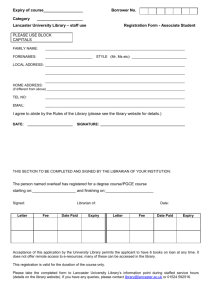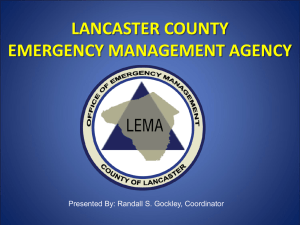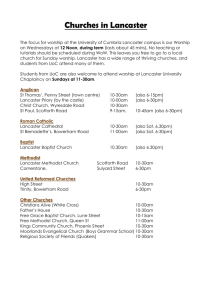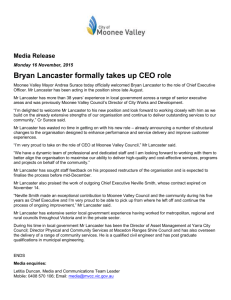- Lancaster, John
advertisement
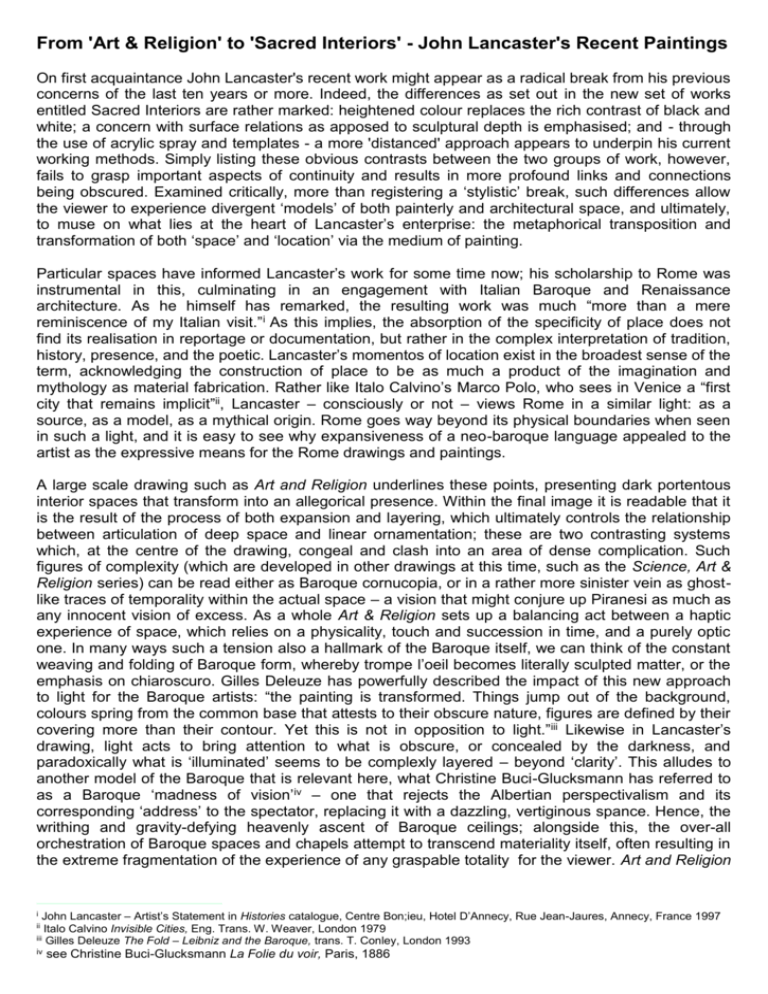
From 'Art & Religion' to 'Sacred Interiors' - John Lancaster's Recent Paintings On first acquaintance John Lancaster's recent work might appear as a radical break from his previous concerns of the last ten years or more. Indeed, the differences as set out in the new set of works entitled Sacred Interiors are rather marked: heightened colour replaces the rich contrast of black and white; a concern with surface relations as apposed to sculptural depth is emphasised; and - through the use of acrylic spray and templates - a more 'distanced' approach appears to underpin his current working methods. Simply listing these obvious contrasts between the two groups of work, however, fails to grasp important aspects of continuity and results in more profound links and connections being obscured. Examined critically, more than registering a ‘stylistic’ break, such differences allow the viewer to experience divergent ‘models’ of both painterly and architectural space, and ultimately, to muse on what lies at the heart of Lancaster’s enterprise: the metaphorical transposition and transformation of both ‘space’ and ‘location’ via the medium of painting. Particular spaces have informed Lancaster’s work for some time now; his scholarship to Rome was instrumental in this, culminating in an engagement with Italian Baroque and Renaissance architecture. As he himself has remarked, the resulting work was much “more than a mere reminiscence of my Italian visit.”i As this implies, the absorption of the specificity of place does not find its realisation in reportage or documentation, but rather in the complex interpretation of tradition, history, presence, and the poetic. Lancaster’s momentos of location exist in the broadest sense of the term, acknowledging the construction of place to be as much a product of the imagination and mythology as material fabrication. Rather like Italo Calvino’s Marco Polo, who sees in Venice a “first city that remains implicit”ii, Lancaster – consciously or not – views Rome in a similar light: as a source, as a model, as a mythical origin. Rome goes way beyond its physical boundaries when seen in such a light, and it is easy to see why expansiveness of a neo-baroque language appealed to the artist as the expressive means for the Rome drawings and paintings. A large scale drawing such as Art and Religion underlines these points, presenting dark portentous interior spaces that transform into an allegorical presence. Within the final image it is readable that it is the result of the process of both expansion and layering, which ultimately controls the relationship between articulation of deep space and linear ornamentation; these are two contrasting systems which, at the centre of the drawing, congeal and clash into an area of dense complication. Such figures of complexity (which are developed in other drawings at this time, such as the Science, Art & Religion series) can be read either as Baroque cornucopia, or in a rather more sinister vein as ghostlike traces of temporality within the actual space – a vision that might conjure up Piranesi as much as any innocent vision of excess. As a whole Art & Religion sets up a balancing act between a haptic experience of space, which relies on a physicality, touch and succession in time, and a purely optic one. In many ways such a tension also a hallmark of the Baroque itself, we can think of the constant weaving and folding of Baroque form, whereby trompe l’oeil becomes literally sculpted matter, or the emphasis on chiaroscuro. Gilles Deleuze has powerfully described the impact of this new approach to light for the Baroque artists: “the painting is transformed. Things jump out of the background, colours spring from the common base that attests to their obscure nature, figures are defined by their covering more than their contour. Yet this is not in opposition to light.”iii Likewise in Lancaster’s drawing, light acts to bring attention to what is obscure, or concealed by the darkness, and paradoxically what is ‘illuminated’ seems to be complexly layered – beyond ‘clarity’. This alludes to another model of the Baroque that is relevant here, what Christine Buci-Glucksmann has referred to as a Baroque ‘madness of vision’iv – one that rejects the Albertian perspectivalism and its corresponding ‘address’ to the spectator, replacing it with a dazzling, vertiginous spance. Hence, the writhing and gravity-defying heavenly ascent of Baroque ceilings; alongside this, the over-all orchestration of Baroque spaces and chapels attempt to transcend materiality itself, often resulting in the extreme fragmentation of the experience of any graspable totality for the viewer. Art and Religion John Lancaster – Artist’s Statement in Histories catalogue, Centre Bon;ieu, Hotel D’Annecy, Rue Jean-Jaures, Annecy, France 1997 Italo Calvino Invisible Cities, Eng. Trans. W. Weaver, London 1979 iii Gilles Deleuze The Fold – Leibniz and the Baroque, trans. T. Conley, London 1993 i ii iv see Christine Buci-Glucksmann La Folie du voir, Paris, 1886 and drawings like it, collapse these various modes of spatial articulation and narrational possibility into the single frame of painterly space, which ultimately inhabits the imaginary and the virtual. Although the more recent Sacred Interiors series employ different means, we find here a similar urge to create a painterly equivalent to the experience of a particular place. The catalyst for these paintings was a visit to the Alhambra Palace in 1996, and here the dominance of Moorish and Islamic décor and their predominant geometric manipulation suggested to Lancaster a new approach to his painting. Using elaborately cut templates he builds up a surface that reflects the complex rhythmicality of the arabesques that adorn the screens and arches; the openness of these spaces flow from one to the other creating the sensation of free circulation. In Sacred Interiors # 3, 1, the vestiges of the dark/light contrasts of the previous series might be found. The others in the series generally adopt a much airier and brighter palette, and explore other means to denote a change in light or suggestion of differentiated spaces. Divisions in these canvases tend to operate in this way, as in #3, 2, where the right hand suggests a more enclosed space than the left, without disrupting the surface play of small geometric motifs. In #3, 4, we find a similar division, only this time further divided into top and bottom. Here, we also find a diagonal cutting across left hand side which acts as a formalised shaft of light, but again is held by the surface continuity. As a group, these works play with such formal divisions, enabling them to act as foil to the almost pointillistic activity that moves across them: there are often horizontal axes which divide the works, and rectangles within rectangles, both creating a sensation of echo and reflection. Water, in the Alhambra’s original state, was abundantly present in the spaces – gushing forth from fountains in most rooms and courtyards, flowing from the mouths of ornate lions into channels which in turn led to the Court of the Pool. The metaphors of flow and eternity renewal remained an important consideration for the architecture of Islam where water was developed as an integral component. Lancaster gives us a more reflective representation – in both the literal and metaphorical sense – and therefore, a more static suggestion of water’s presence in these pieces. Reflection and inversion govern the repetition and permutation of these geometric and architectural forms giving coherence at the macro and the macro level. Such procedures conjure up a musical analogy, which Lancaster himself has used in order to shed light on the weaving of such forms across the canvas: “The fugue is structured to create a subject which fluently progresses the main theme to a secondary role. As well as the subject or main theme, a piece is introduced which compliments or acts as an answer to the subject. Both subject and answer are used to compliment and act as contrapuntal devices for textural variation, with reversal roles competing for dominant and secondary positions.”v This dialogue between dominant and secondary, between foreground and background, primary motif and accompaniment, might be analogous to way forms overlap, are then ‘screened’, layered or disrupted in these paintings. Fugal technique, in itself, has strong architectural overtones, a point that was not lost on the composers or architects of the Baroque. In fact, the cliché of architecture as ‘frozen music’ also alludes (in negative) to the temporal flow of fugal counterpoint, where each perceived moment is poised between the past and the future; the whole ‘architecture’ of which is constructed in the mind of the listener via memory and expectation. Such ‘virtual’ architecture is not, in fact, so foreign to Lancaster’s own aims, as illustrated in these recent pictorial translations of environmental spaces into two dimensions, as in his earlier investigations of Renaissance and Baroque buildings; in different ways both rely on a weaving of what he calls a ‘spatial ambiguity’ – a cutting across interior or exterior space, and a movement from the actual (as in the physicality of the building) to the virtual (the multiple and implied spaces of painting). Marcel Proust once referred to this virtuality as “Real without being actual, ideal without being abstract” vi, and in this sense, painting has always been the virtual medium par excellence. Re-constructed in the mind of the viewer, ‘The picture is neither a real object or an imaginary object’vii as Barthes once put it. Lancaster deals with this directly – in the collapse of physically occupied space into surface, which in turn also reflects the potentiality of layering as being both literal and also a condensation of perceptual memory. Are these v John Lancaster, 1997, Op. Cit. Quoted in John Rajchman, ‘The Virtual House’ in Constructions, MIT Press, 1998 vii Roland Barthes, ‘Is painting a Language?’ in the Responsibility of Forms, trans. R. Howard, New York 1999 vi recent paintings of the Alhambra Palace? Or can we perceive the ghost of the Italian Palazzo della Concelleria? The answer is of course, neither, or rather both. Lancaster attempts to engage a reflection back onto the possibility of painting as a medium, with its rich capacity for combination and synchronicity, and ultimately the construction of an interface between the real and the imaginary. © David Ryan 1999
